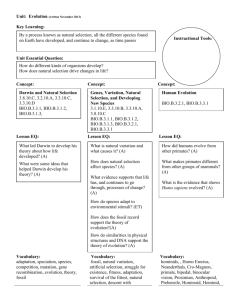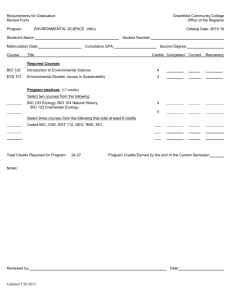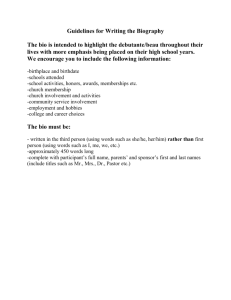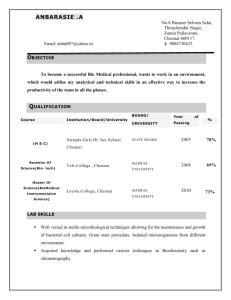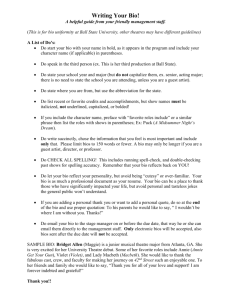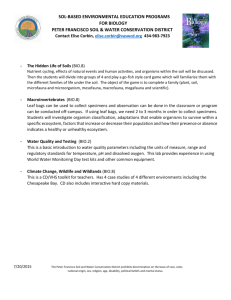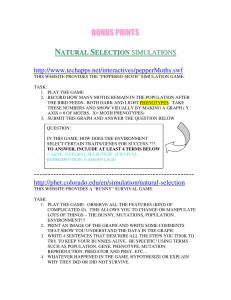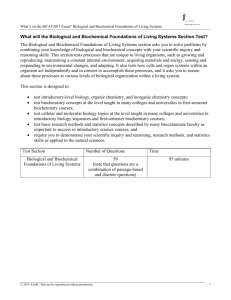Unit 3
advertisement
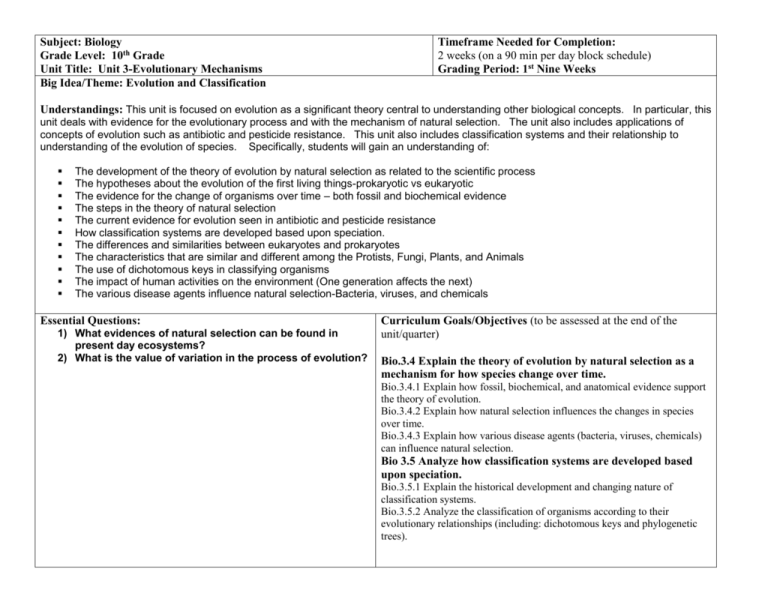
Subject: Biology Grade Level: 10th Grade Unit Title: Unit 3-Evolutionary Mechanisms Big Idea/Theme: Evolution and Classification Timeframe Needed for Completion: 2 weeks (on a 90 min per day block schedule) Grading Period: 1st Nine Weeks Understandings: This unit is focused on evolution as a significant theory central to understanding other biological concepts. In particular, this unit deals with evidence for the evolutionary process and with the mechanism of natural selection. The unit also includes applications of concepts of evolution such as antibiotic and pesticide resistance. This unit also includes classification systems and their relationship to understanding of the evolution of species. Specifically, students will gain an understanding of: The development of the theory of evolution by natural selection as related to the scientific process The hypotheses about the evolution of the first living things-prokaryotic vs eukaryotic The evidence for the change of organisms over time – both fossil and biochemical evidence The steps in the theory of natural selection The current evidence for evolution seen in antibiotic and pesticide resistance How classification systems are developed based upon speciation. The differences and similarities between eukaryotes and prokaryotes The characteristics that are similar and different among the Protists, Fungi, Plants, and Animals The use of dichotomous keys in classifying organisms The impact of human activities on the environment (One generation affects the next) The various disease agents influence natural selection-Bacteria, viruses, and chemicals Essential Questions: 1) What evidences of natural selection can be found in present day ecosystems? 2) What is the value of variation in the process of evolution? Curriculum Goals/Objectives (to be assessed at the end of the unit/quarter) Bio.3.4 Explain the theory of evolution by natural selection as a mechanism for how species change over time. Bio.3.4.1 Explain how fossil, biochemical, and anatomical evidence support the theory of evolution. Bio.3.4.2 Explain how natural selection influences the changes in species over time. Bio.3.4.3 Explain how various disease agents (bacteria, viruses, chemicals) can influence natural selection. Bio 3.5 Analyze how classification systems are developed based upon speciation. Bio.3.5.1 Explain the historical development and changing nature of classification systems. Bio.3.5.2 Analyze the classification of organisms according to their evolutionary relationships (including: dichotomous keys and phylogenetic trees). Molecular Biology Bio.1.1 Understand the relationship between the structures and functions of cells and their organelles. Bio.1.1.2 Compare prokaryotic and eukaryotic cells in terms of their general structures (plasma membrane and genetic material) and degree of complexity. Essential Skills/Vocabulary: Synthesizing information from several sources Processing of observed and gathered evidence, then forming and testing hypotheses that explain the evidence. Read and manipulate data to create graphs of results. Examine the development of the theory of biological evolution including: The origins of life, patterns, variation, and natural selection. Connect biochemical evidence for evolution and how it relates to other types of evidence. Design a species that will be able to survive and thrive in a particular environment. Process of using a dichotomous key Complete a concept map, including information about evolution and classification. Examine the development of the theory of evolution by natural selection including: Assessment Tasks: 1. Writing Assessment: If you could ask Darwin one question, what would it be and why? 2. Writing Activity: The Scientific Process and Evolution Activity (Little Red Riding Hood and 3 Little Pigs Cartoon Activity) 3. How can fossil evidence be used to understand evolution? Use this guiding question for Fossil comparison activity. http://www.fossilmuseum.net/EdResources/FossilImages.htm 4. Fishing Frenzies (Honors and Academic variations available) 5. Rat Island Activity 6. Sex and the Single Guppy http://www.pbs.org/wgbh/evolution/sex/guppy/ed_pop.html 7. http://www.pbs.org/wgbh/evolution/ Darwin’s Dangerous Idea Video Clips and Worksheet that goes along with the video clips. 8. Common Name vs. Scientific Name Activity (online) 9. Evolution Concept Map 10. Comparison of Prokaryotic and Eukaryotic 11. Class scape Unit 3 Test Materials Suggestions: The Scientific Process and Evolution Activity - http://www.wcer.wisc.edu/ncisla/muse/naturalselection/materials/section1/index.html Fossil Comparison Activity - http://www.fossilmuseum.net/EdResources/FossilImages.htm Several different types of fossils are needed Sex and the Single Guppy - http://www.pbs.org/wgbh/evolution/sex/guppy/ed_pop.html Mobile Lab or computer lab is needed for several of these activities.
